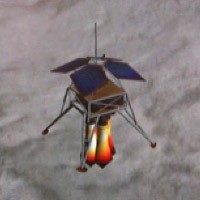
Small Spacecraft Working Group
Tags: autonomous, nasa, robots, vision
In 2006, the Intelligent Systems Division at Ames (with a few partners at JPL and elsewhere) convened a Small Spacecraft Working Group to do end-to-end integration testing of various spacecraft technologies we’d been developing. The concept involved a small lunar lander with the ability to use its thrusters to relocate a small number of times after landing. The team designed the lander hardware in just enough detail to flesh out the scenario, and then we integrated mission planning and execution software, machine vision software, system health monitoring software, propultion control, and a number of other modules in an end-to-end simulation. (The image above shows a frame from the core physics-based spacecraft dynamics simulation software.) I was brought in as a robot vision consultant.
 It was a fun project. I got to learn VxWorks (the OS we chose to run on the virtual lander) and port key pieces of the Vision Workbench to it. I got to spec out spacecraft cameras and write simulation modules for the cameras themselves, creating a virtual lunar terrain for the robot to fly around in. Finally, I got to flesh out the core stereo reconstruction and hazard detection system that the software used to select a safe landing spot. The image at left shows some of the diagnostic output from the hazard detector.
It was a fun project. I got to learn VxWorks (the OS we chose to run on the virtual lander) and port key pieces of the Vision Workbench to it. I got to spec out spacecraft cameras and write simulation modules for the cameras themselves, creating a virtual lunar terrain for the robot to fly around in. Finally, I got to flesh out the core stereo reconstruction and hazard detection system that the software used to select a safe landing spot. The image at left shows some of the diagnostic output from the hazard detector.
Although the only major output of the working group was a big final report, the integration testing did give each of the teams a good opportunity to iron out some of the kinks in their code. A number of people from the working group later went on to help develop the real Ames prototype lunar lander, as well as the spacecraft for the LADEE mission to analyze the Moon’s thin dusty atmosphere.



